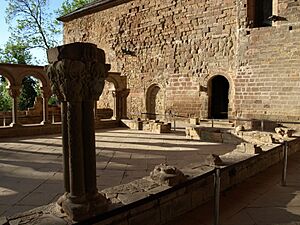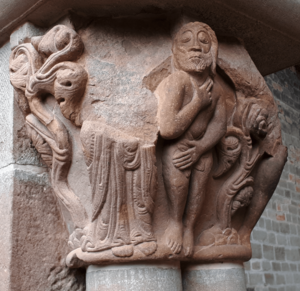Royal Monastery of San Juan de la Peña facts for kids
The Monastery of San Juan de la Peña is a very old and important religious building. It is located near the town of Santa Cruz de la Serós. This town is in the province of Huesca, Spain, southwest of Jaca. In the Middle Ages, this monastery was one of the most important in the region of Aragon.
What makes it special is how it's built. Part of its church has two levels. These levels are carved right into the side of a huge cliff! The name San Juan de la Peña means "Saint John of the Cliff."
The older part of the monastery was built in the year 920. It has some unique mozarabic designs. These designs come from a time when Christians lived under Muslim rule in Spain. Most of the monastery, including its amazing cloister, is built in the Romanesque style. This style was popular in Europe a long time ago. The cloister is a covered walkway, often with arches, found in monasteries.
In 1675, a big fire damaged the monastery. So, a new monastery was built nearby. The old monastery was named a National Monument in 1889. The new one became a National Monument in 1923. In the 11th century, the monastery joined the Benedictine Order. This was a group of monks. It was also the first monastery in Spain to use the Latin Mass. This was a special religious service.
Contents
Exploring the Monastery
The monastery's cloister was built around the year 1190. It has many stone carvings called capitals. These are the decorated tops of columns. The capitals show scenes from the Bible. They were originally placed in order, like a story. This kind of design was also found in other places nearby.
A Royal Resting Place
The monastery is built under a giant rock. Some people connect this rock to a legendary place called "Monte Pano." On the second floor of the monastery, there is a special room. This room is a royal pantheon. It is where kings of Aragon and Navarre were buried.
The room you see today was designed in 1770. This was during the time of Charles III of Spain. It has beautiful marbles and stucco decorations. These decorations show famous battles from history. Some of the kings buried here include Ramiro I, Sancho Ramírez, and Peter I of Aragon and Navarre.
The Legend of the Holy Grail
There is a famous legend about the monastery. It says that the chalice from the Last Supper was sent here. This chalice is also known as the Holy Grail. People believed it was sent to the monastery for safety. This was to protect it from Muslim invaders in Spain.
The legend claims this is the same cup that was given to the Valencia Cathedral in 1438. This gift was from Alfonso V of Aragon. You can find more details about this special cup by looking up Santo cáliz.
A Famous Chronicle
The monastery is also famous for something else. It is the namesake of the Chronicle of San Juan de la Peña. A chronicle is like a historical record or story. Parts of this important historical document were researched and written at the monastery itself.
See also
 In Spanish: Real Monasterio de San Juan de la Peña para niños
In Spanish: Real Monasterio de San Juan de la Peña para niños




